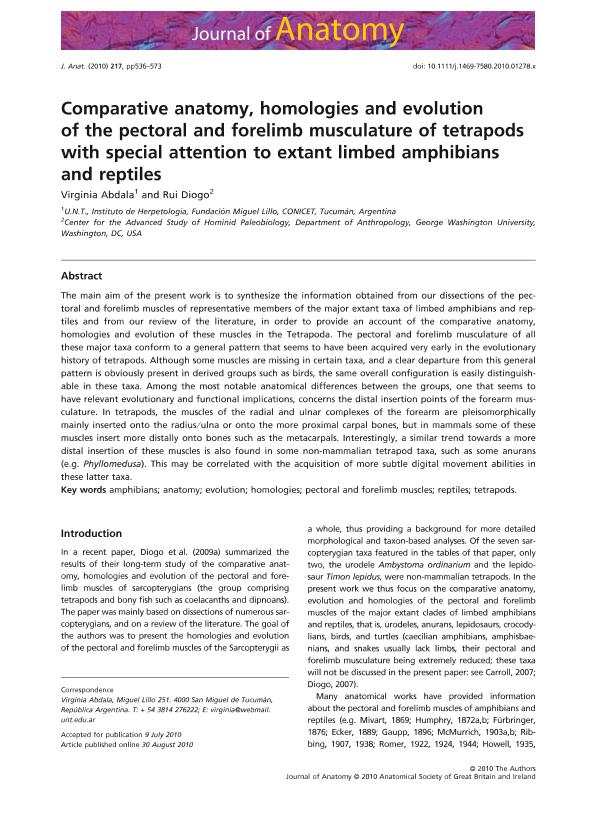Mostrar el registro sencillo del ítem
dc.contributor.author
Abdala, Virginia Sara Luz

dc.contributor.author
Diogo, Rui
dc.date.available
2019-04-12T20:02:20Z
dc.date.issued
2010-11
dc.identifier.citation
Abdala, Virginia Sara Luz; Diogo, Rui; Comparative anatomy, homologies and evolution of the pectoral and forelimb musculature of tetrapods with special attention to extant limbed amphibians and reptiles; Wiley Blackwell Publishing, Inc; Journal of Anatomy; 217; 5; 11-2010; 536-573
dc.identifier.issn
0021-8782
dc.identifier.uri
http://hdl.handle.net/11336/74303
dc.description.abstract
The main aim of the present work is to synthesize the information obtained from our dissections of the pectoral and forelimb muscles of representative members of the major extant taxa of limbed amphibians and reptiles and from our review of the literature, in order to provide an account of the comparative anatomy, homologies and evolution of these muscles in the Tetrapoda. The pectoral and forelimb musculature of all these major taxa conform to a general pattern that seems to have been acquired very early in the evolutionary history of tetrapods. Although some muscles are missing in certain taxa, and a clear departure from this general pattern is obviously present in derived groups such as birds, the same overall configuration is easily distinguishable in these taxa. Among the most notable anatomical differences between the groups, one that seems to have relevant evolutionary and functional implications, concerns the distal insertion points of the forearm musculature. In tetrapods, the muscles of the radial and ulnar complexes of the forearm are pleisomorphically mainly inserted onto the radius/ulna or onto the more proximal carpal bones, but in mammals some of these muscles insert more distally onto bones such as the metacarpals. Interestingly, a similar trend towards a more distal insertion of these muscles is also found in some non-mammalian tetrapod taxa, such as some anurans (e.g. Phyllomedusa). This may be correlated with the acquisition of more subtle digital movement abilities in these latter taxa.
dc.format
application/pdf
dc.language.iso
eng
dc.publisher
Wiley Blackwell Publishing, Inc

dc.rights
info:eu-repo/semantics/openAccess
dc.rights.uri
https://creativecommons.org/licenses/by-nc-sa/2.5/ar/
dc.subject
Amphibians
dc.subject
Anatomy
dc.subject
Evolution
dc.subject
Homologies
dc.subject
Pectoral And Forelimb Muscles
dc.subject
Reptiles
dc.subject
Tetrapods
dc.subject.classification
Otras Ciencias Biológicas

dc.subject.classification
Ciencias Biológicas

dc.subject.classification
CIENCIAS NATURALES Y EXACTAS

dc.title
Comparative anatomy, homologies and evolution of the pectoral and forelimb musculature of tetrapods with special attention to extant limbed amphibians and reptiles
dc.type
info:eu-repo/semantics/article
dc.type
info:ar-repo/semantics/artículo
dc.type
info:eu-repo/semantics/publishedVersion
dc.date.updated
2019-04-11T19:47:55Z
dc.journal.volume
217
dc.journal.number
5
dc.journal.pagination
536-573
dc.journal.pais
Reino Unido

dc.journal.ciudad
Londres
dc.description.fil
Fil: Abdala, Virginia Sara Luz. Consejo Nacional de Investigaciones Científicas y Técnicas. Centro Científico Tecnológico Conicet - Tucumán; Argentina. Fundación Miguel Lillo. Dirección de Zoología. Instituto de Herpetología; Argentina
dc.description.fil
Fil: Diogo, Rui. The George Washington University; Estados Unidos
dc.journal.title
Journal of Anatomy

dc.relation.alternativeid
info:eu-repo/semantics/altIdentifier/doi/https://doi.org/10.1111/j.1469-7580.2010.01278.x
dc.relation.alternativeid
info:eu-repo/semantics/altIdentifier/url/https://onlinelibrary.wiley.com/doi/10.1111/j.1469-7580.2010.01278.x
dc.relation.alternativeid
info:eu-repo/semantics/altIdentifier/url/https://www.ncbi.nlm.nih.gov/pmc/articles/PMC3035861/
Archivos asociados
